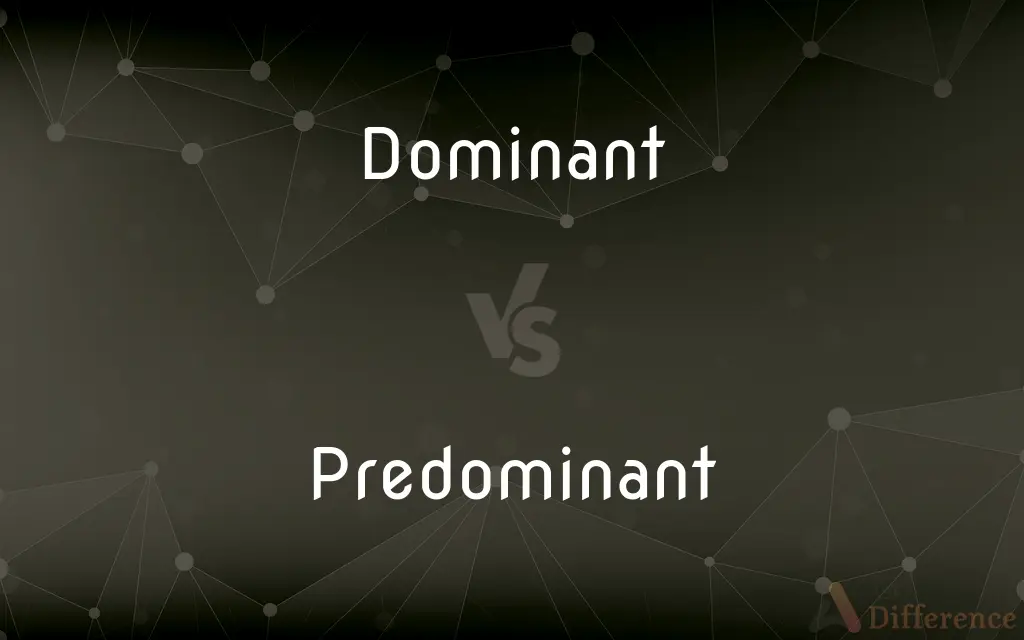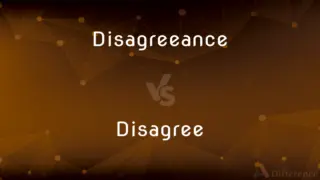Dominant vs. Predominant — What's the Difference?
By Tayyaba Rehman & Maham Liaqat — Updated on March 7, 2024
Dominant refers to the most powerful or influential element, often exerting control or authority. Predominant emphasizes being the most common or widespread, highlighting quantity or prevalence over control.

Difference Between Dominant and Predominant
Table of Contents
ADVERTISEMENT
Key Differences
Dominant describes an element that has control, authority, or a position of power over others. It implies a hierarchal superiority, whether in genetics, social settings, or competitive environments. For example, in a classroom, the teacher holds a dominant position due to their authority and responsibility. Predominant, on the other hand, refers to something that is the most common or widespread in a particular area or at a particular time. It emphasizes the aspect of being more noticeable or prevalent than others, rather than having control or power. For instance, in a garden, if most flowers are red, red is the predominant color.
While the term "dominant" often involves an element of power dynamics, indicating that one entity exerts influence or control over others, "predominant" focuses on the aspect of being most frequent or widespread, without necessarily implying power or control.
A dominant trait is one that is expressed in the phenotype even when only one allele is present, overshadowing the recessive allele. This is different from predominant, which would refer to the most common trait found in a population, not necessarily related to genetic dominance.
In cultural or societal contexts, a dominant culture is one that holds sway over others, shaping laws, norms, and public policies. Meanwhile, a predominant language or custom in a multicultural society is the one most commonly used or practiced, regardless of the power dynamics involved.
Dominant and predominant can sometimes be used interchangeably when describing the most noticeable or influential feature in a context. However, the distinction lies in "dominant" conveying control or superiority, and "predominant" indicating numerical superiority or widespread presence.
ADVERTISEMENT
Comparison Chart
Definition
Having control or authority; most influential.
Most common or widespread.
Focus
Power, control, superiority.
Frequency, prevalence.
Usage Context
Genetics, social dynamics, competitive settings.
Demographics, characteristics of a group or area.
Example
The dominant political party in a government.
The predominant color in a painting.
Compare with Definitions
Dominant
Most powerful or influential in a group or area.
In the ecosystem, the lion is considered the dominant predator.
Predominant
Present as the strongest or main element.
Green is the predominant color in the rainforest.
Dominant
In genetics, an allele that expresses its phenotype even in the presence of a recessive allele.
Brown eyes are a dominant trait in humans.
Predominant
Most noticeable or important.
The predominant feature of the landscape is the large mountain range.
Dominant
Most important, powerful, or influential.
The dominant theme of the novel is the struggle between good and evil.
Predominant
Most frequent or common in occurrence.
Online learning has become the predominant method of education.
Dominant
Possessing authority or influence over others.
The company's dominant position in the industry is due to its innovative products.
Predominant
Having or exerting control or power.
The predominant winds in the region are from the west.
Dominant
Predominating over others; commanding.
The dominant narrative in the media often shapes public opinion.
Predominant
Widespread in a particular area at a particular time.
The use of smartphones is predominant among teenagers.
Dominant
Exercising the most power, control, or influence
The dominant nations during the Cold War.
Predominant
Having the most importance, influence, or force
The predominant theory in the field.
Dominant
Most abundant or conspicuous; predominant
"[The fireplaces'] shallow brick arches are a relief from the dominant squares and verticals of the windows and doors" (Stephen A. Kliment).
Predominant
Most common or conspicuous; main or prevalent
"Egrets, gulls and small mammals are the predominant wildlife on the island these days" (Dan McCoubrey).
Dominant
Higher; overlooking
Dominant hills.
Predominant
Common or widespread; prevalent.
Dominant
Tending to be stronger than its counterpart or used for the most important tasks or in the most pressing situations
Which is your dominant eye? Throw the ball with your dominant arm.
Predominant
Significant or important; dominant.
Dominant
(Genetics) Of, relating to, or being an allele that produces the same phenotypic effect in heterozygotes as in homozygotes.
Predominant
(music) A subdominant.
Dominant
(Ecology) Of, relating to, or being a species that is most characteristic of an ecological community and usually determines the presence, abundance, and type of other species.
Predominant
Having the ascendency over others; superior in strength, influence, or authority; prevailing; as, a predominant color; predominant excellence.
Those help . . . were predominant in the king's mind.
Foul subordination is predominant.
Dominant
(Music) Relating to or based on the fifth tone of a diatonic scale.
Predominant
Most frequent or common;
Prevailing winds
Dominant
(Genetics) A dominant allele or a trait produced by a dominant allele.
Predominant
Having superior power and influence;
The predominant mood among policy-makers is optimism
Dominant
(Ecology) A dominant species.
Dominant
(Music) The fifth tone of a diatonic scale.
Dominant
(music) The fifth major tone of a musical scale (five major steps above the note in question); thus G is the dominant of C, A of D, and so on.
Dominant
(music) The triad built on the dominant tone.
Dominant
(genetics) A gene that is dominant.
Dominant
A species or organism that is dominant.
Dominant
Ruling; governing; prevailing
The dominant party controlled the government.
Dominant
Predominant, common, prevalent, of greatest importance.
The dominant plants of the Carboniferous were lycopods and early conifers.
Dominant
Preferred and used with greater dexterity than the other, as the right hand of a right-handed person or the left hand of a left-handed one.
Dominant
(medicine) Designating the follicle which will survive atresia and permit ovulation.
Dominant
(music) Being the dominant
Dominant seventh
Dominant
Ruling; governing; prevailing; controlling; predominant; as, the dominant party, church, spirit, power.
The member of a dominant race is, in his dealings with the subject race, seldom indeed fraudulent, . . . but imperious, insolent, and cruel.
Dominant
The fifth tone of the scale; thus G is the dominant of C, A of D, and so on.
Dominant
(music) the fifth note of the diatonic scale
Dominant
Exercising influence or control;
Television plays a dominant role in molding public opinion
The dominant partner in the marriage
Dominant
Of genes; producing the same phenotype whether its allele is identical or dissimilar
Common Curiosities
How do dominant and predominant apply in social contexts?
In social contexts, a dominant group may control cultural norms and policies, while predominant refers to the most common practices or characteristics within a population.
What is the difference between dominant and predominant?
Dominant implies power, authority, or superiority, often in a controlling sense. Predominant refers to what is most common or widespread, emphasizing prevalence rather than control.
Is dominant always related to genetics?
While dominant is a term used in genetics to describe an allele that expresses its phenotype over a recessive allele, it is also broadly used to describe any controlling or influential force in various contexts.
In ecology, how do dominant and predominant species differ?
In ecology, a dominant species is one that exerts a strong influence on its environment and the distribution of other species, often because of its biomass, productivity, or sheer numbers. A predominant species, meanwhile, is simply the most common or abundant species in a given area, without necessarily having a controlling influence on the ecosystem.
Can market dominance and market predominance be used interchangeably?
While related, market dominance and market predominance have nuanced differences. Market dominance refers to a company's control over an industry or sector, often reflected in high market share, pricing power, and competitive advantage. Market predominance refers to the most common or widespread presence in the market, which might not necessarily include control over the market dynamics or competitive strategies.
Can something be both dominant and predominant?
Yes, an element can be both dominant and predominant if it is the most influential or powerful and also the most common or widespread in a particular context.
Can the predominant element in a group be different from the dominant one?
Yes, the predominant element refers to what occurs most frequently, which might not necessarily have the power or influence that a dominant element possesses.
Does the concept of dominance imply negative consequences?
Not necessarily. While dominance can imply a form of control or authority that could lead to negative consequences such as suppression of diversity or competition, it can also signify leadership, innovation, and positive influence within a community, industry, or ecosystem. The impact of dominance depends on how it is exercised and the context in which it exists.
Can a dominant trait be less common than a recessive trait in a population?
Yes, a dominant trait can be less common than a recessive trait in a population due to various factors, such as selective pressures or the population's genetic makeup. Dominance in genetics refers to the expression of an allele, not its frequency within a population.
How does cultural dominance differ from cultural predominance?
Cultural dominance refers to the influence or control one culture exerts over others, often through power dynamics, institutions, or policies. Cultural predominance, however, refers to the most widespread or commonly practiced culture or cultural traits within a given area or society, without implying control.
Share Your Discovery

Previous Comparison
Downstage vs. Upstage
Next Comparison
Disagreeance vs. DisagreeAuthor Spotlight
Written by
Tayyaba RehmanTayyaba Rehman is a distinguished writer, currently serving as a primary contributor to askdifference.com. As a researcher in semantics and etymology, Tayyaba's passion for the complexity of languages and their distinctions has found a perfect home on the platform. Tayyaba delves into the intricacies of language, distinguishing between commonly confused words and phrases, thereby providing clarity for readers worldwide.
Co-written by
Maham Liaqat














































